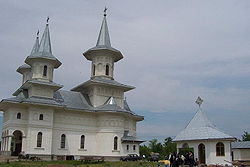
Liesti
Encyclopedia

Romania
Romania is a country located at the crossroads of Central and Southeastern Europe, on the Lower Danube, within and outside the Carpathian arch, bordering on the Black Sea...
, the third largest commune of Galați County
Galati County
Galaţi is a county of Romania, in Moldavia region, with the capital city at Galaţi.-History:Historically Galaţi is part of Moldavia...
, on the confluence of the Siret
Siret River
The Siret or Sireth is a river that rises from the Carpathians in the Northern Bukovina region of Ukraine, and flows southward into Romania for 470 km before it joins the Danube...
and Bârlad
Bârlad River
The Bârlad is a river in eastern Romania, a tributary of the Siret River. Its total length is 207 km. Its source is in the low hills between the Siret and Prut rivers, southwest of Iaşi. It flows generally south, through the cities of Negreşti, Vaslui, Bârlad and Tecuci. The Bârlad river flows...
rivers, very close to Tecuci
Tecuci
Tecuci is a city in the Galaţi county of Romania , situated among wooded hills, on the right bank of the Bârlad River, and at the junction of railways from Galaţi, Bârlad and Mărăşeşti.-History:...
(28 km) and Galați
Galati
Galați is a city and municipality in Romania, the capital of Galați County. Located in the historical region of Moldavia, in the close vicinity of Brăila, Galați is the largest port and sea port on the Danube River and the second largest Romanian port....
(52 km). It is composed of two villages, Liești and Șerbănești. The latter is the southernmost part of the commune.
Name
The name of the commune appears to have derived from Ilie, which means Elijah, probably a local, which seams to be the brother of Şerban, the father of Şerbăneşti.History
The first mention of the village dates from 1448, when in the prince of Moldavia, Petru IIPetru II of Moldavia
Petru II of Moldavia was hospodar of Moldavia, son of Alexandru cel Bun. He co-ruled Moldavia with his brother, Stephen II of Moldavia, during 1444-1445, in 1447-1448 with Roman II of Moldavia, and in 1448-1449 alone....
, who gives as a gift to the local nobleman Cernat Ploscarul and to his brother, Ştefu, 40 villages and fields among which appear Lieşti and Şerbăneşti.
Tourist sights
Lieşti has several Romanian OrthodoxRomanian Orthodox Church
The Romanian Orthodox Church is an autocephalous Eastern Orthodox church. It is in full communion with other Eastern Orthodox churches, and is ranked seventh in order of precedence. The Primate of the church has the title of Patriarch...
churches - St. Parascheva (c. 1886), Dormition of the Virgin (1889), and St. Nicholas (built after 1990)- the seat of the Protopopiate (vice-bishopric) of Nicoreşti.
Other attractions include the acacia
Acacia
Acacia is a genus of shrubs and trees belonging to the subfamily Mimosoideae of the family Fabaceae, first described in Africa by the Swedish botanist Carl Linnaeus in 1773. Many non-Australian species tend to be thorny, whereas the majority of Australian acacias are not...
forests near the village (especially in May) and the picturesque valleys of the rivers Siret and Bârlad.
Education
Lieşti has four schools: one which teaches until the tenth grade, and three that teach until the eighth grade. Lieşti also has 4 kindergartens and a 14,000 volume public library.Economy
The village has a sugar factory (Lemarco Bucharest), but the majority of the population works in local agriculture or in siderurgy at the Siderurgical Combinate Mittal Steel from Galaţi.Beginning around 2000, many people from the region have gone to work in Italy or Spain, where wages are higher.

